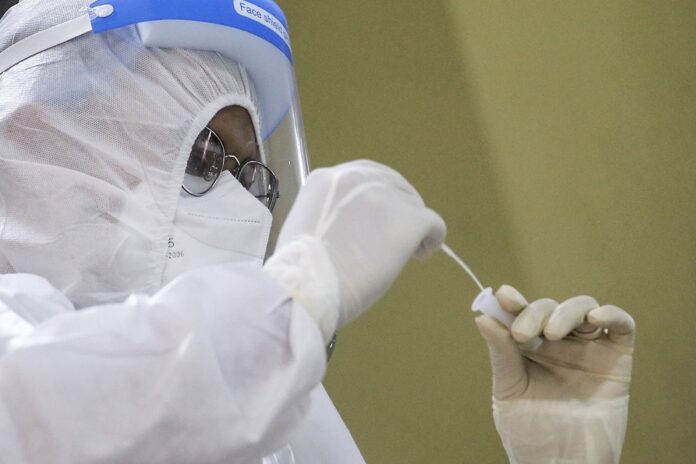A health worker conducts a Covid-19 swab test at Dewan Seri Siantan in Selayang May 19, 2020. — Picture by Hari Anggara
KUALA LUMPUR, Oct 3 — October is set to be an important month, as Covid-19 infections decline, and more activities resume, with the rate of fully vaccinated adults reaching the 90 per cent target, and an increasing number of adolescents also receiving the jab.
Cross-state movements, the opening of tourism centres, students returning to universities and schools, and spectators heading to sports venues are among the activities set to come back to life.
Schools need to be reopened to provide a morale boost to students after a long hiatus of learning from home, although the issue of some teachers refusing to be vaccinated, is a worry for parents.
Nevertheless, it is too early for Malaysians to celebrate, as it is still uncertain if the endemic phase can be reached by end of October, with certain variants, especially the Delta one, said to have not yet undergone a mutation process, which could endanger more lives.
Therefore, everyone is advised not to become complacent, and continue to be careful and adhere to the standard operating procedures (SOP) set by the government, to prevent the cases from going up again.
This is the hope of the Covid-19 Pandemic Management Special Committee chaired by Prime Minister Datuk Seri Ismail Sabri Yaakob, which decides on all proposals for action towards the endemic phase, after they are refined at the Covid-19 Ministerial Quartet meeting led by Senior Defence Minister Datuk Seri Hishammuddin Hussein.
All the proposals are first identified and discussed at the Pandemic Management Technical Working Group-level chaired by National Security Council director-general Datuk Rodzi Md Saad.
According to Public Health Specialist, Universiti Putra Malaysia (UPM) Assoc Prof Dr Malina Osman, despite being given freedom, the community must continue adhering to standard operating procedures (SOPs) and preventive measures, to avoid the possibility of transmission and emergence of new clusters.
The Ministry of Health is targeting for Malaysia to enter a transition phase of ‘living with the Covid-19 virus’ before moving into the endemic phase, with the number of cases being within the expected range and not burdening public health facilities, depending on the strength and duration of resistance derived from vaccinations and natural immunity.
Among the indicators for the country moving into the endemic phase is that the critical cases rate per 100,000 of the population should be 0.5, whereby the rate as of Sept 25 was 1.9.
Apart from that, hospital admission rates for categories three to five should be at five per cent of the total, where the percentage as of Sept 25 was 10 per cent, while non-Intensive Care Unit (ICU) hospital bed utilisation should be less than 30 per cent, and those in ICUs should be below 20 per cent.
For the public, the endemic phase means they need to continue to comply with the revised and simplified SOPs, be responsible and ensure there is proper access to health care at all times.
In the transition from the pandemic to endemic phase, several things need to be taken into account, including not being able to avoid the Covid-19 virus for life, but being able to minimise its impact, as well as controlling severe cases with a lesser burden on the health system.
In the meantime, five strategies have been outlined by the government for the transition to the endemic phase, the first, involving the public health response and vaccination programmes using the find, test, trace, isolate, and support (FTTIS) approach, vaccination of 70 to 90 per cent of the total population, giving booster shots, and ensuring good and safe ventilation practices.
The second strategy involves testing and monitoring, namely the use of self-test kits, near-patient or point-of-care testing (POCT), faster test kits using respirators, and enhanced surveillance methods.
The third strategy is case management, which will ensure that there is adequate bed capacity at hospitals, as well as effective treatment and protection for those at risk.
The fourth strategy is community empowerment to encourage people to do self-testing, self-isolation, adhere to SOPs, be agents of change and increase mental resilience.
The fifth strategy is border control, where quarantine policies and SOPs are continued, with test and release practices and the use of ‘green/amber/red’ lists.
Another main factor to consider before moving to the endemic phase is the level of infection, as during the pandemic phase, the level of infection is high, while in the endemic phase, the number of infections is low.
Among the actions that need to be implemented to achieve this is increased response, including vaccination, increased testing and monitoring, as well as increased preparedness to face new clusters or waves of infections.
There should also be ceiling prices set for important medical equipment such as self-test kits, to ensure that they can be bought by the public, besides having subsidies for the B40 group, as well as price and quality monitoring.
In terms of managing cases, the virtual Covid-19 Assessment Centre (CAC) will be continued and expanded, while the private sector would also need to play a greater role moving forward.
For case management in hospitals, selected hospitals would be identified as Covid-19 hospitals with at least one Covid-19 hospital per hospital cluster, with a minimum of 42 such hospitals nationwide. — Bernama



